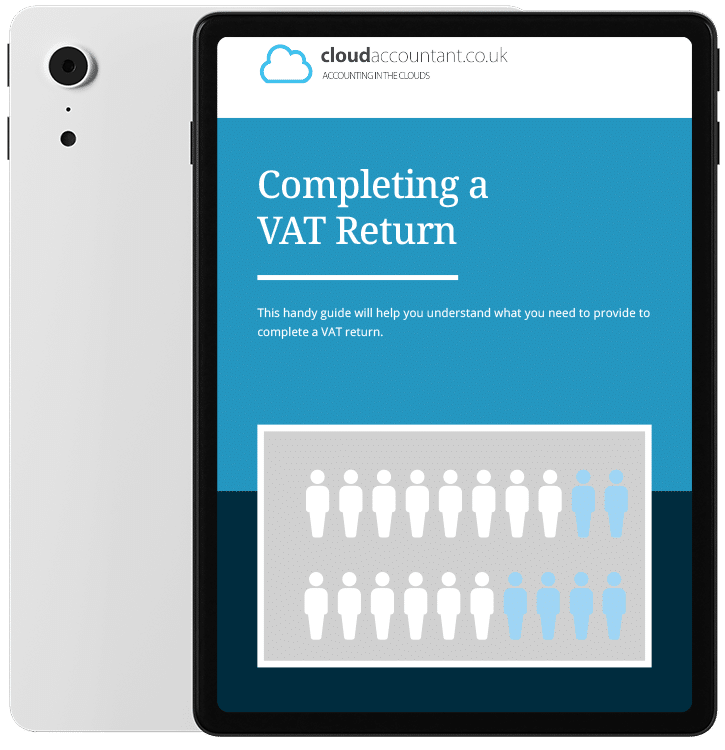What is a VAT return?
As a VAT-registered business, you’re responsible for collecting VAT on your sales and paying it across to HMRC.
If you use the Standard Rate scheme, you’re able to reclaim the VAT you pay on your allowable business expenses. With the Standard Rate scheme, if you’ve collected more VAT than you’ve paid out, you need to pay the difference over to HMRC. If you’ve paid more VAT than you’ve made in sales, HMRC will refund you the difference.
If you’re on the Flat Rate scheme, you keep the difference between what you charge your customers and pay to HMRC
What is reported in the return?
The VAT return records things for the accounting period like:
- Your total sales and purchases
- The amount of VAT you owe
- The amount of VAT you can reclaim
- What your VAT refund from HMRC is
You must submit a VAT return even if you have no VAT to pay or reclaim.
What can you claim VAT on?
If you buy stock or services from another VAT-registered company and they charge you VAT on that purchase, you can claim the VAT back through your tax return.
If you are on the Standard Rate scheme, you will be able to see a full breakdown of the allowable business expenses in our Expenses Guide. The amount of VAT you will be able to reclaim will be dependent on the VAT rate for each type of expense.
If you are on the Flat Rate scheme, you cannot reclaim the VAT on your purchases – except for certain capital assets over £2,000.
What can’t you claim VAT on?
If a business expense isn’t classed as allowable, you can’t claim the VAT back. That means anything that’s bought for personal use, and things like business entertainment can’t be claimed for.
If you buy exempt items, there’s no VAT to reclaim.
If you buy anything under the second-hand margin scheme, you’re not able to claim back VAT on the purchase.
Different VAT rates
One complexity that comes with VAT returns is recognising the different rates of VAT.
There are three rates of VAT that are applied to goods and services in the UK.
1. Standard Rate (20%)
2. Reduced Rate (5%)
3. Zero Rate (0%)
Items may also be exempt (or ‘outside the scope’) of VAT.
As well as the different rates VAT is charged at, the different VAT schemes change how the returns are produced. Please see our VAT Guide, an introduction for small businesses to learn about the various VAT accounting schemes.
What do you need to provide for the return?
For us to prepare the return, you will need to provide the following:
- A copy of all your business bank statements
- Details of any zero-rated products you have sold
- Upload all expense receipts with the VAT element visible
You can’t claim the VAT back on your purchases without a corresponding VAT invoice. You also need to ensure you keep a copy of every sales invoice you create, even ones created by mistake or canceled.
You need to provide a full invoice for all transactions. However, for retail supplies over £250 you can use a modified invoice. And for retail supplies under £250, you’re able to provide a simplified invoice.
There are very strict rules about what can and can’t be submitted as part of the return, to avoid abuse of the system.
Examples of receipts
For small purchases below £250, you’re able to use till receipts as evidence on your VAT return. They must contain the following information:
1. The name, address, and VAT number of the company you’ve purchased from
2. A unique ID number
3. The time and date
4. A description of the goods or services
5. The amount of VAT
6. The total amount of the sale including VAT
HMRC insists you keep your records for at least 6 years. If they decide to open an investigation into your returns, you need to be able to provide your historic records, including every relevant receipt and sales invoice.
When you’re not required to issue a VAT invoice
There are a few instances when there’s no requirement to create a VAT invoice. For example, if you’re goods are sold under a second-hand margin scheme, and the customer you’re dealing with operates a self-billing arrangement or if the zero rates of VAT apply to the entire invoice.
When are VAT returns due?
For monthly and quarterly VAT returns, the deadline for submission is always one calendar month and seven days after the end of your VAT period.
If the quarter end is 30th April, the VAT submission and payment are due by 7th June.
Annual VAT returns are due 2 months after the end of the return period.
If you need any more advice on VAT returns, VAT schemes, or VAT invoices, please get in touch with the team today.








